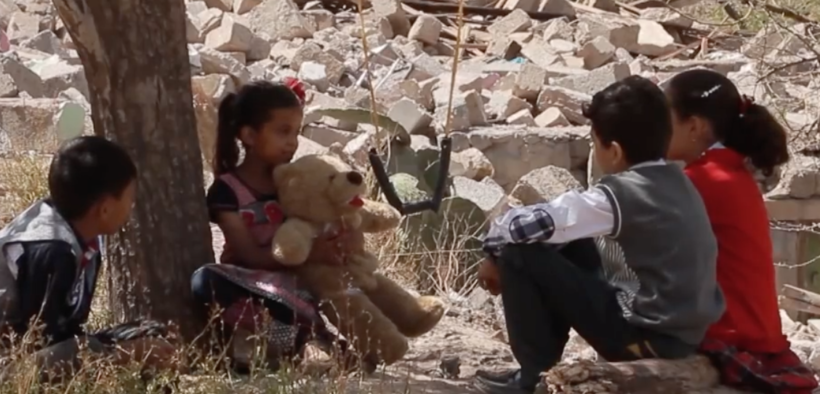Saudi Arabia Violates its Own Ceasefire As Yemen Announces First Cases of Coronavirus

The Saudi regime has engaged in a number of questionable activities since the global outbreak of COVID-19, including moving masses of African refugees deported from areas with coronavirus to the Yemeni border.
(By: Ahmed Abdulkareem, Mintpress News) Thursday proved to be a tragic day for internally displaced people in the Al-Mazraq Refugee Camp in Yemen’s northern Hajjah Province. The camp lies on the outskirts of Haradh city near the Yemen-Saudi border.
Residents of the camp were shocked by the sound of huge explosions and aircraft buzzing overhead, especially as news had just reached the camp that Saudi Arabia had announced a ceasefire in Yemen amid a coronavirus outbreak ravaging members of its monarchy. By the end of the day, it was clear that the Saudi military was behind the attacks. It had launched an operation aimed at capturing a customs port in Haradh, just 20 kilometers away from the refugee camp.
Even after repeated calls by the United Nations to halt the war in Yemen in order to prevent the spread of the novel coronavirus (COVID-19), Saudi Arabia continued operations in the country unabated. On Wednesday night, however, the Kingdom finally announced that it was halting military operations in order to “avoid a potential outbreak.” Despite the public announcement, by Thursday morning, the Kingdom had launched its campaign in Haradh.
Saudi Coalition spokesman Col. Turki al-Malki claimed that Saudi Arabia was suspending military operations in order to “support of UN efforts to end its five-year war and avoid a potential outbreak of the new coronavirus.” The Coalition has made no mention of lifting its blockade on the country in order to allow medical aid or supplies to enter.
“The move was aimed at creating favorable conditions for a UN-supervised meeting to pave the way for a permanent ceasefire in Yemen,” Maliki said in a statement released by the official Saudi Press Agency. The spokesman claimed the ceasefire would go into effect on Thursday and last for two weeks. The move, which is renewable, “is an opportunity to reach a comprehensive and lasting cease-fire in Yemen,” according to Maliki.
Shortly after the ceasefire was announced, Saudi Coalition jets struck several civilian targets in Sa’ada, Amran, al-Bayda, Hajjah, and Jawf. Moreover, new military operations supported by American military advisors began in several areas near the Saudi-Yemen border. This included the attacks on the Haradh customs port as well as airstrikes in Rasha Asir and Al-Baqa’a in Najran.
Saudi Arabia’s announcement of a ceasefire, which it violated almost immediately, is not without precedent. In January 2016, the Saudi-led coalition announced it would no longer observe a ceasefire that it had announced on December 15 in the midst of UN-brokered talks aimed at ending the war.
Ansar Allah, the political wing of Yemen’s Houthi movement, the primary force fighting to repel Saudi forces from Yemen, downplayed the Saudi ceasefire announcement, describing it as a maneuver, tactical step and an attempt to evade responsibility for the consequences of the spread of COVID-19.
Mohammed AbdulSalam, the spokesman for Ansar Allah, said on Thursday that the Saudi initiative is a political and media maneuver and has multiple aims, including improving the “stained and bloody” image of Saudi Arabia and trying to thwart negotiations between the United Nations and Ansar Allah to end the war on Yemen.
Mohammed al-Bukhaiti, a senior member of Ansar Allah’s Political Bureau, said that the Saudi initiative does not express a conviction for peace, but is simply a tactical move. Al-Bukhaiti urged Riyadh to use the outbreak of COVID-19 as an opportunity for a genuine ceasefire and a face-saving exit from the Yemen war.
Ansar Allah, like most Yemenis, believes that any truce that does not involve lifting the blockade imposed in 2016 would be a continuation of the Saudi war. That blockade has effectively handcuffed Yemeni authorities from managing the coronavirus threat. In fact, just one after the blockade, at least 60 percent of Yemen’s health facilities had closed for good and those that remained operational lacked specialists, essential equipment, and medicine as they were unable to restock due to the blockade.
Furthermore, a host of epidemics such as diphtheria, cholera, dengue fever, swine flu, and malaria are already sweeping refugee camps, making it nearly impossible for people to effectively face the coming coronavirus pandemic. “To us, if even Saudi stops the war, it is time to dig our graves and wait quietly for death,” a 35-year-old refugee in the Al-Mazraq Refugee Camp told MintPress.
Coronavirus officially hits Yemen
The first official coronavirus cases in Yemen were confirmed in Hadhramout two days ago. The World Health Organisation (WHO) and Save the Children have both warned of an impending explosion of coronavirus cases in the country. Xavier Joubert, the Country Director for Save the Children in Yemen said:
Today, the first case of Covid-19 was confirmed in Yemen. This is a moment we all feared, and were hoping to avoid, because Yemen is critically under-equipped to face this virus. Only half of Yemen’s health facilities are still fully functional. There are 700 intensive care unit beds, including 60 for children, and 500 ventilators for a population of about 30 million.
Dr. Taha al- Mutwakel, head of the Sana’a-based Ministry of Health and Population told members of the Yemeni parliament, “if COVID-19 spreads in Yemen it will kill at least 500,000 people.” He added, “The oxygen plants were destroyed, there are only 1,000 beds across the country and 400 ventilators.”
Waiting quietly for death
Given how quickly the virus is spreading around the world, COVID-19 will almost certainly gain a foothold in Yemen, especially ravaging refugees already suffering from compromised immune systems. According to the Ministry of Health, the virus will affect 90 percent of the population and will be especially deadly to those living in refugee camps.
Most Yemenis do not have the luxury of buy cleaning tools and sterilizers or calling epidemiological centers when they’re sick. Even washing their hands with clean water can prove challenging, let alone practicing social distancing. In the Al-Mazraq Refugee Camp, multiple families are often forced to share the same utensils, bathrooms, cooking supplies, and tents and the camps’ residents often struggle with underlying health conditions like malnutrition and cholera, making them even more vulnerable to the virus.
Even outside the camps, the intensive care that COVID-19 patients need when they develop acute respiratory distress syndrome is virtually nonexistent in Yemen. While the World Health Organization has provided 30 “heat testing devices” to the country, they require officials to confirm cases before they will send aid, according to the Secretary-General of the National Council for the Administration and Coordination of Humanitarian Affairs in Sana’a.
Weaponizing the virus
To make matters worse, Saudi Arabia has engaged in a number of questionable practices that have Yemeni citizens fearing the Kingdom is intentionally trying to expedite the spread of COVID-19.
In Wadi Al-Dhamd, a valley that straddles the border between Yemen and Saudi Arabia and connects directly to Yemen’s district of Al-Raqaw, the Saudi regime has relocated hundreds of African refugees deported from the Kingdom. Citizen cell phone video shows masses gathering in the area in a move Yemenis fear could be an attempt to spark a COVID-19 outbreak among the refugee population in order to spread it to local residents according to authorities in Sadaa.
Al-Raqaw is dotted with refugee camps inhabited by thousands of migrants from Ethiopia and Somalia that were deported from Saudi Arabia. They often pay Yemeni smugglers to transport them to large cities in the country in hopes of fleeing life in crowded refugee camps. Many of the African migrants are believed to have been deported from areas of Saudi Arabia where the coronavirus is spreading. Since the COVID-19 pandemic began, the Saudi regime has also expelled thousands of Yemeni workers.
Dr. Hussein Maqbouli, the Head of the Sana’a-based Higher Ministerial Committee for Epidemic Control, told a local TV news channel Thursday night that only 76 quarantine centers had been set up across Yemen’s 12 provinces. He noted that 400 people are still arriving every day at the Afar Port in Al-Beidha Province, a total of 12,000 per month. This, at a time when most countries have suspended inbound flights in an effort to contain the pandemic. The Saudi coalition has near complete control of Yemen’s airspace.
Officials in Sana’a have warned against the continual deportation of Yemenis from Saudi Arabia into Yemen and the Coalition’s continued flights into the city of Aden without observing any quarantine measures. They say that moves fit into a framework of Coalition plans to introduce the virus into Yemen. Mohsen Tawoos, the Secretary General of the National Council for the Administration and Coordination of Humanitarian Affairs, want as far as to say that Saudi Arabia in intentionally deporting those affected by COVID-19 to Yemen.
Ahmed AbdulKareem is a Yemeni journalist. He covers the war in Yemen for MintPress News as well as local Yemeni media.







